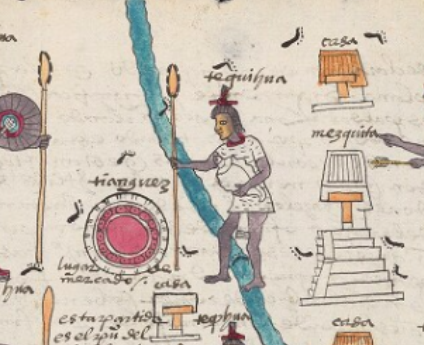tianquiztli (Mdz67r)
This compound glyph of a market (tianquiztli) involves a series of concentric circles, some white and some red. Details are drawn in black lines, including hash marks inside the outer rim, and inside that a thin blank white ring, then a wider ring with black circles with dots in the center, and this whole ring is painted red. Inside that is another narrow white ring, and finally, the center circle is plain except for being painted red. This is the semantic visual element that conveys marketplace. Three black footprints move around the outside of these concentric circles, suggesting the movement of people around the marketplace and providing the phonetic value, -quiz, from the verb quiza, to emerge.
Stephanie Wood
In the contextualizing image, the market is not far from the "mezquita" (at is is glossed in Spanish and showing Spaniards' experience with the reconquest of the Iberian peninsula from the Moors). The mezquita is actually the teocalli, or principal temple of the community here). A river flow nearby the market, too. In this context, one can also see footprints moving toward the market from some distance on both sides. Some of the other glyphs for marketplaces in this collection feature footprints, suggesting that the presence of people is a common feature. See below for some examples. Note how different the marketplaces appear by 1580–81, in the two examples provided from the Relaciones Geográficas, where rectangles have replaced circles and the central fountain predominates inside the rectangles.
Footprint glyphs have a wide range of translations. In this collection, so far, we can attest to yauh, xo, pano, -pan, paina, temo, nemi, quetza, otli, iyaquic hualiloti, huallauh, tepal, tetepotztoca, totoco, otlatoca, -tihui, and the vowel "o." Other research (Herrera et al, 2005, 64) points to additional terms, including: choloa, tlaloa, totoyoa, eco, aci, quiza, maxalihui, centlacxitl, and xocpalli.
Stephanie Wood
tianguez
tianquiz(tli)
Stephanie Wood
c. 1541, or by 1553 at the latest
Stephanie Wood
mercados, tianguis, huellas, rojo, huella, footprint, footprints, pie, pies, steps, pasos, icximachiyotl, xocpalli, icxipamitl

tianquiz(tli), market, https://nahuatl.wired-humanities.org/content/tianquiztli
el mercado
Stephanie Wood
Codex Mendoza, folio 67 recto, https://digital.bodleian.ox.ac.uk/objects/2fea788e-2aa2-4f08-b6d9-648c00..., image 144 of 188.
Original manuscript is held by the Bodleian Libraries, University of Oxford, MS. Arch. Selden. A. 1; used here with the UK Creative Commons, “Attribution-NonCommercial-ShareAlike 3.0 License” (CC-BY-NC-SA 3.0)







